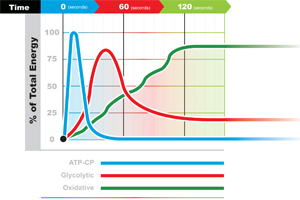ARTICLE SHORTCUTS
Most of us understand our bodies about as well as we understand our cars. We know we’re supposed to take them out for a spin once in a while, and keep them well fueled. But when it comes to grasping precisely how that fuel gets converted into motion — well, we’re not entirely sure.
So let’s take a look under the hood, shall we?
Like a hybrid engine, your body has several ways of turning the stuff you eat into the stuff you do. All of these metabolic energy systems are switched on during physical activity, but each plays a different role depending on available energy and the specific demands of the task. Each burns a particular type of fuel at a particular rate — thereby affecting fat loss and muscle gain in a particular way.
These are the three systems:
- The adenosine triphosphate–creatine phosphate (ATP-CP) system, or phosphagen system, supports very brief, high-intensity activities like a single-effort vertical jump.
- The glycolytic system provides energy for activities of slightly longer duration and lower intensity like strength training.
- The oxidative system supports long-duration, lower-intensity activities like walking or distance running.
In recent years, exercise physiologists have learned how to target each system with specialized training to better prepare individuals for a specific event or sport.
Discover how your body’s energy systems interact — how to challenge each one so you can reach your fitness goals faster and more efficiently.
First Responder: The ATP-CP Energy System
Whether you’re running a 40-meter dash, jumping up to answer the phone, or catching a child falling off the monkey bars, the ATP-CP system is first to respond. Among your three energy systems, it’s the fastest, and the one most prepared for emergencies. It kicks in whenever the oxidative system, your body’s normal method for providing energy, isn’t fast enough to handle the demands you’re placing on it.
All three of your energy systems ultimately run on adenosine triphosphate, or ATP. It fuels all your physical functions — eating, breathing, running hill sprints. These systems aim to provide your body with enough ATP, in a timely manner, to perform whatever task you’re asking it to do. Your glycolytic and oxidative systems make most of this ATP, producing it as the need arises from the food you eat and air you breathe.
A small quantity of ATP is socked away in your muscles for when you need to expend a short burst of energy in a hurry. Let’s say you’re doing a single barbell squat with close to max weight. As you power the weight up, the muscles of your hips, thighs, and lower back immediately burn through their ATP stores. Once the ATP has done its job, it’s either further broken down or recycled (with the help of creatine phosphate, or CP), so it can provide more energy to your working muscles.
How fast does this system gear up? Blink and you’ll miss it. “Once you begin hard activity, it takes just thousandths of a second for the phosphagen system to kick in,” explains Christopher Scott, PhD, a University of Southern Maine professor of exercise, health, and sport sciences.
There’s a cost for this speed and efficiency, however: You can store only enough ATP and CP in your muscles to fuel about six to 10 seconds of serious effort. Training the ATP-CP pathway will improve your explosive speed and power (so you can jump higher, sprint faster, and throw farther), but it won’t increase your storehouses of ATP-CP — or give you the ability to operate at full throttle for longer than a few seconds. That’s why activities like javelin throwing, Olympic weightlifting, and the 100-meter dash are “one and done” endeavors, even at the elite level. Most trained athletes need three to five minutes of rest before their ATP is replenished enough to perform near the level of their previous effort.
ATP-CP also comes into play in everyday life, whenever you’re dashing to catch an elevator, for instance, or grabbing a vase before it topples over.
“As we age, we lose a lot of our ability to exert strength quickly,” says Scott. “So doing some of this training is important simply for maintaining quality of life.”
ATP-CP training doesn’t typically burn a lot of fat or build a lot of muscle, but that doesn’t mean you should cut it out. For one thing, it can be fun — and since you’re performing fewer reps, it won’t make you particularly sore. It’s also the best way to build serious strength, speed, and power.
How do you train the ATP-CP system? “Intermittent training,” says physical therapist Bill Hartman, PT, CSCS, co-owner of Indianapolis Fitness and Sports Training. This means brief periods (10 seconds or less) of high effort with lots of rest (two minutes or more) between activities.
Training Your ATP-CP System
Speed: Explosive
Primary Fuel: Adenosine triphosphate and creatine phosphate, stored in your muscles
Sample Activities: Swinging a golf club, sprinting to first base, lifting a heavy weight one to three times
How to Train It: Heavy strength training, medicine-ball throws, jumps, short sprints, sports-specific drills. (Try our explosive power workout to train this system.)
Sets/Reps/Rest:
- Three to eight sets
- Maximum-effort sets lasting eight to 15 seconds; one or two heavy reps in strength-training activities
- Long rest between sets (up to five minutes); full recovery between efforts
Frequency: Up to three times a week
How fast does the ATP-CP system gear up? Blink and you’ll miss it.
Athletes with well-trained ATP-CP systems are fast, strong, and explosive, specializing in brief, single-effort activities like swinging a softball bat, Olympic weightlifting, high-jumping, and shot-putting. Athletes competing in field and team sports, such as soccer, lacrosse, tennis, martial arts, basketball, and other activities, also rely heavily on the ATP-CP system during the highest-effort moments of sprinting, kicking, or driving to the hoop.
Fast and Furious: The Glycolytic Energy System
As your ATP-CP system sputters out, your glycolytic system steps in and keeps you moving for about another minute or so before it, too, begins to run out of fuel.
If you’ve ever done an all-out set of max pushups or a 400-meter sprint, you’re familiar with what it feels like to exercise the glycolytic system at close to its maximum. In a word, it hurts.
Glycolysis relies on energy converted from carbohydrates (glucose) into ATP. The burning sensation you feel during exercise is caused by a buildup of hydrogen ions, a byproduct of glycolysis, which can inhibit muscle contraction, resulting in wobbly knees after a minute or so of full-out effort.
The more you train your glycolytic system, however, the better you’re able to buffer these ions and the faster you can recover between sets.
Fitness pros recommend this approach for people who want to gain muscle, lose fat, and get the most out of their time at the gym.
“A 400-meter sprinter is a great example of an athlete whose training is mostly glycolytic,” says exercise physiologist Mike Nelson, PhD. “It’s a nice compromise between strength and endurance work.”
Glycolytic training burns fat so effectively because it creates a significant “metabolic disturbance,” he explains. And recovering from it requires work from all three energy systems. In this way, glycolytic training improves the functioning of each individual system, and the ability to transition smoothly among them.
Metabolic flexibility is a significant component of long-term health and fitness, Nelson notes, and “smart training doesn’t just develop the three systems in isolation — it also develops your ability to transition from one fuel source to another so all three metabolic pathways work together effectively.”
Diabetics and the very obese tend to be metabolically inflexible. To a lesser degree, athletes on carb-restricted diets, such as the ketogenic approach — which pushes the body to burn fat as an energy source rather than carbs and sugars — may also struggle to transition between energy systems. Curb carbs sharply, says Nelson, “and your carb-burning machinery can’t run to its full extent.”
Competitive athletes and serious exercisers on a keto diet may feel this deficiency when they try to push for extra speed at the end of a race and find it’s not there.
The best way to train your glycolytic system is through repeated high-effort activity, with less-than-complete recovery between efforts:
20- to 30-second sprints on foot, in a pool, or on a bike, with a minute of rest between them; or strength training in sets lasting 30 to 60 seconds. Many field sports also train this pathway.
Training Your Glycolytic System
Speed: Medium-fast to fast
Primary Fuel: Carbohydrate
Sample Activities: Traditional strength training; 200- to 400-meter sprinting; 50-meter freestyle swimming
How to Train It: Medium-intensity strength training, interval training, running stadium stairs or hills, shaking battling ropes, jump-rope sprints, kettlebell workouts; swimming repeats. (Try our hill-run or HIIT jump-rope workouts to train this system.)
Sets/Reps/Rest:
- Two to four sets
- High effort for sets lasting 20 to 40 seconds; eight to 12 reps in strength-training activities
- Short rest between sets (two minutes or less); partial recovery between efforts
Frequency: Twice a week per muscle group or area of the body trained
If you’ve ever done a 400-meter sprint, you’re familiar with what it feels like to exercise the glycolytic system. In a word, it hurts.
Glycolytic athletes specialize in activities lasting 30 seconds to two minutes or so. They’re fast and seemingly tireless — though perhaps not quite as strong as the ATP-CP athlete, nor as enduring as the oxidative athlete — and they tend to be muscular and lean. This type of training is ideal for burning fat (in recovery) and building muscle mass. Strength training using sets of eight to 12 reps and sprinting 400 meters or less typify glycolytic training.
Long, Slow Burn: The Oxidative Energy System
The oxidative (or aerobic) system is your slow-burning furnace, always humming in the background, whether you’re fast asleep or running hard. It’s fueled largely by fat and glucose. Of the three metabolic pathways that support exercise, it’s the only one that directly requires oxygen to function.
“We’re predominantly aerobic creatures,” says Scott. “We can go weeks without food, days without water, but if we’re deprived of oxygen for more than a few minutes, we’re dead.”
So, although it’s slower to ramp up during exercise, the oxidative system is the most important energy system of all. If it doesn’t work, neither do you.
Athletes competing in any long-distance endurance sport — cycling, running, cross-country skiing, triathlon — all need exceptional aerobic capacity, as do those playing continuous-action field and team sports, like basketball, soccer, and Ultimate Frisbee.
Fortunately, the oxidative system is responsive to exercise. “Through training, you can increase the capacity of your aerobic metabolism up to 240 percent,” says Hartman. “And the better it works, the more effectively you burn fat in your workouts.”
Although this system is continuously active and produces loads of energy, the process of converting fat into usable energy can take a while. Once it begins, though, it’s your body’s most reliable engine over long periods of time. During a 10-second sprint, Hartman says, your aerobic system is able to kick in only about 13 percent of the necessary energy; on an intense four-minute run, however, its contribution rises to 80 percent.
Exercise physiologists once believed that the best way to develop the oxidative system was through long, slow cardio workouts — an hour or more several times a week. It certainly responds well to this type of training, but recent research suggests that this system also works hard — very hard, in fact — to help you recover after a high-intensity anaerobic effort like a set of squats or a hill sprint. Do a second, third, and fourth set before you’ve fully recovered from the previous one and it ramps up its efforts even higher.
“A strength-training workout resembles a series of escalating waves of effort for the oxidative system,” says Nelson. That’s why you’re winded after high-intensity bouts of strength training and sprinting, even though the activities themselves are technically anaerobic. The system shifts into overdrive to replenish the depleted ATP-CP stores and clear out the glycolytic byproducts generated by your other two energy systems.
At the conclusion of an intense strength-training or interval-training workout, your oxidative system often continues to work overtime, typically for hours, sometimes for a day or two. This is a phenomenon known as excess postexercise oxygen consumption, or EPOC, a process that contributes to fat-burning long after the workout ends.
Unless you’re a competitive endurance athlete, you probably don’t need hours and hours of long, slow cardio every week. Higher-intensity activities can be equally effective at building cardiovascular health and helping you stay lean.
Exercise your oxidative system by jumping rope, training with light weights, or performing standard cardio exercises for periods of one to five minutes, resting one to five minutes between sets, for up to six sets.
If you’re serious about building your aerobic capacity, you can also do one to five high-effort bouts of 10 to 20 minutes, resting five to 10 minutes between them.
Because low-intensity aerobic activity speeds recovery from the minor damage caused by other forms of exercise, perhaps the best use of oxidative training is as a restorative tool on your off days.
Training Your Oxidative System
Speed: Slow to medium
Primary Fuel: Fat
Sample Activities: Jogging, slow swimming, cycling, walking, hiking, martial arts, continuous-action team sports (basketball, ultimate Frisbee, soccer)
How to Train It: Light circuit training, running five minutes or more, long-distance cycling, traditional cardio machines, long, slow swimming.
Sets/Reps/Rest:
- Either three to six one- to five-minute medium-high efforts with one to five minutes rest between sets, or
- One to three eight- to 20-minute medium efforts, resting four to 10 minutes between reps
Frequency: One to three times a week
Although it’s last to kick in, the oxidative system is the most important energy system of all. If it doesn’t work, neither do you.
Oxidative athletes are typically leaner and lighter than the other two athletic types. They can go on forever at a slow-to-medium pace, burning mostly fat — the ultimate high-efficiency, slow-burning fuel. Oxidative training is essential for endurance sports, but athletes in field sports shouldn’t neglect this kind of training. Done in moderation, oxidative training is also great for helping you recover from other, more intense forms of exercise.
Full Speed Ahead: An Energy Systems Timeline
Let’s say you’re going out for a run and you want to see just how hard you can go and for how long. You lace up your shoes, start your stopwatch, and off you go. Here’s a moment-by-moment timeline of what’s happening in your three energy systems as you burn up the road.
ATP-CP System
0 seconds–10 seconds
The millisecond you start, all three energy systems are primed to go to work. But the first to fire up is the ATP-CP system, which burns highly combustible fuels, including adenosine triphosphate, that are stored inside your working muscles. Like the fuel in a dragster engine, it burns hot and fast. It’s all but spent in about 10 seconds.
Glycolytic System
10 seconds–75 seconds
Next to get going is the glycolytic system, which ramps up its efforts just seconds into your run and draws primarily on carbohydrate fuel. As your leg muscles churn through those carbs, hydrogen ions and other byproducts inhibit muscle contraction and make your legs ache. Try as you might, you can’t help but slow down a bit.
Oxidative system
75 seconds–10 minutes and more
The oxidative system has been generating energy this whole time, but it’s been working on other things simultaneously (like digestion and cardiovascular function). During your run, your body shifts more of its focus to delivering oxygen to your working muscles, using fat as its primary fuel. Burning fat takes longer than burning carbs, though, so you’ll be compelled to slow your pace.
Once your oxidative system kicks in, it generally stays on the job and can keep going long after the other two systems peter out. If you reach your top aerobic pace (a point just below your anaerobic threshold, or AT), you should be able to hold on to it for quite a while — hours, if you are well trained. And highly trained endurance athletes can hover at or even a little above their AT for an hour or so.|
Fuel Interaction
 This chart shows how the body’s three energy systems interact and support each other during the first 130 seconds of sustained activity. Out in front is the ATP-CP system (blue), providing a short, initial burst of intense energy. The glycolytic system (red), only minimally involved at the start, quickly increases its output as the ATP-CP system drops off. As more sustained effort becomes necessary, the oxidative system (green) takes over. You can see from the transitional phases how the three systems cooperate to provide just the right energy at the right time.
This chart shows how the body’s three energy systems interact and support each other during the first 130 seconds of sustained activity. Out in front is the ATP-CP system (blue), providing a short, initial burst of intense energy. The glycolytic system (red), only minimally involved at the start, quickly increases its output as the ATP-CP system drops off. As more sustained effort becomes necessary, the oxidative system (green) takes over. You can see from the transitional phases how the three systems cooperate to provide just the right energy at the right time.
Recommended Reading on Anaerobic Threshold
- How to Find Your Anaerobic Threshold
- How to Calculate Your Anaerobic Threshold
- The Active Metabolic Assessment: The Most Accurate Test For Cardio Training
- Overtraining: Myths, Facts and Fantasies
- The Tabata Tune-Up
This article originally appeared as “All Systems Go” in the June 2012 issue of Experience Life.




This Post Has 0 Comments